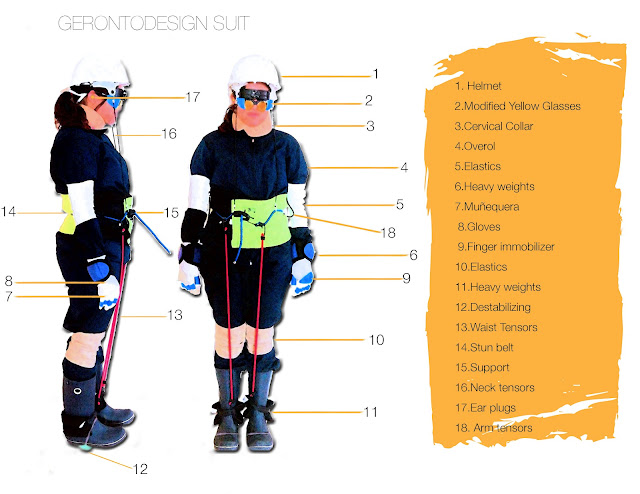As a designers we know that we need to know the necessities of the people, but I will tell you : Im not agree with this.
This suit should work according to vectors, making the exact strength in the right spot to avoid the displacement of the body.
According to AGE LAB:
• The knee and elbow mobility limitations will place, for the simulation of joint stiffness and muscle fatigue increases will slow movement.
• Arms: bands will place connected to the arm and the waist of the person to reduce the mobility of the shoulder joints will be more difficult to reach objects above shoulder height.
• Legs: We will use straps and a harness attached to shoes, to reduce the flexibility of the hamstring, the step is shortened, the leg movements during walking will be shorter and slower.
• The backbone: The accessories of the hull and the band, simulate the compression and rotation of the vertebrae, giving the user a sense of curvature of the spine that occurs with aging.
• Neck: We will use a cervical collar, as it reduces the rotation of the cervical spine and extension, this will cause the entire torso movements to want to rotate.
• Eyes: The use of yellow glasses will be to impair color vision, in addition to them will be difficult to see in dim light.
• Ears: use earplugs to simulate difficulties sharp sounds and tones.
• Balance: The shoes will simulate the changes that occur in our musculoskeletal system in the inner ear, causing imbalance also give us a sense of uncertainty at each step.52
• Hands: The use of gloves and wristbands will be to simulate the reduction in tactile sensitivity, and decreased strength and mobility of the wrist.
Besides these additions, by and based on this research it was decided to add the following:
• In eyes: Different types of lenses to experiment:
✴ Total blindness
✴ Myopia Presbyopia
Why?
Because we doesn't only need to know the necessities, we need to comprehend it , to be emphatic with the user, and start calling him : persona.
I made an experiment…
The Age Lab (MIT) (http://agelab.mit.edu/), BLUM (http://www.blum.com)and NISSAN (http://jalopnik.com/360954/nissan-engineers-simulate-elderly-experience-with-old-people-suit) already made it too. Its about feeling old, feel like an elder feels. I need to tell you that in 2005 Ron Navarro start to talking about this "experiments", he teach me how to start to think more in the "others", using masking tape in my fingers and trying to open a water bottle.
I recommend to to this experiment, if you need to design for elders, its the best way to understand them, not only physically, but emotional and mental ways too.
Here I exposed the elements that you will need to "feeling" like an older person:
This suit should work according to vectors, making the exact strength in the right spot to avoid the displacement of the body.
According to AGE LAB:
• The knee and elbow mobility limitations will place, for the simulation of joint stiffness and muscle fatigue increases will slow movement.
• Arms: bands will place connected to the arm and the waist of the person to reduce the mobility of the shoulder joints will be more difficult to reach objects above shoulder height.
• Legs: We will use straps and a harness attached to shoes, to reduce the flexibility of the hamstring, the step is shortened, the leg movements during walking will be shorter and slower.
• The backbone: The accessories of the hull and the band, simulate the compression and rotation of the vertebrae, giving the user a sense of curvature of the spine that occurs with aging.
• Neck: We will use a cervical collar, as it reduces the rotation of the cervical spine and extension, this will cause the entire torso movements to want to rotate.
• Eyes: The use of yellow glasses will be to impair color vision, in addition to them will be difficult to see in dim light.
• Ears: use earplugs to simulate difficulties sharp sounds and tones.
• Balance: The shoes will simulate the changes that occur in our musculoskeletal system in the inner ear, causing imbalance also give us a sense of uncertainty at each step.52
• Hands: The use of gloves and wristbands will be to simulate the reduction in tactile sensitivity, and decreased strength and mobility of the wrist.
Besides these additions, by and based on this research it was decided to add the following:
• In eyes: Different types of lenses to experiment:
✴ Total blindness
✴ Myopia Presbyopia
✴ Halo effect of vision due to retinal problems.
• In the hands thick gloves will be used and if possible be bandaged hand to experience the feeling of a person with advanced arthritis.
• In the torso: is added using a belt to prevent further rotation of the spine will also heat the body, which starts to run out due to pressure and temperature rise, this in order to mimic the usual fatigue in an older age.
• In the hands thick gloves will be used and if possible be bandaged hand to experience the feeling of a person with advanced arthritis.
• In the torso: is added using a belt to prevent further rotation of the spine will also heat the body, which starts to run out due to pressure and temperature rise, this in order to mimic the usual fatigue in an older age.
*The numer 7 "muñequera" is a wrist bracelet.
Using this suit the designer will know something more about the elder person….. much!!
Using this suit the designer will know something more about the elder person….. much!!
:)
